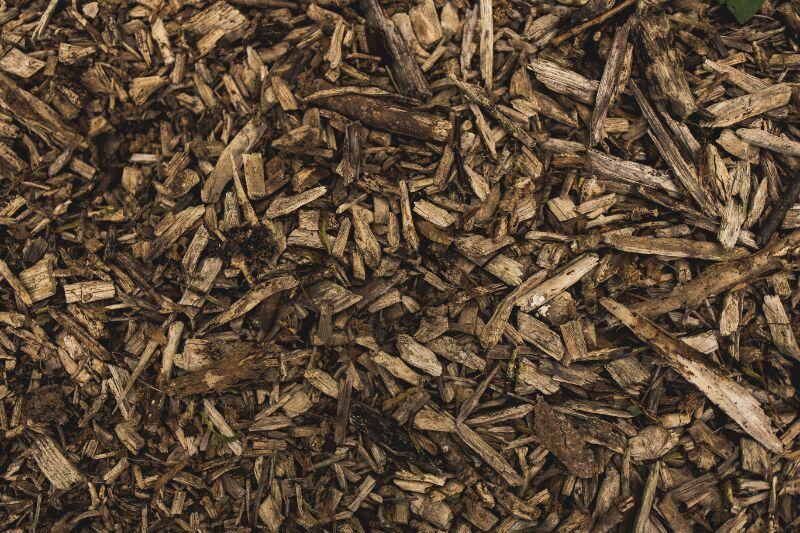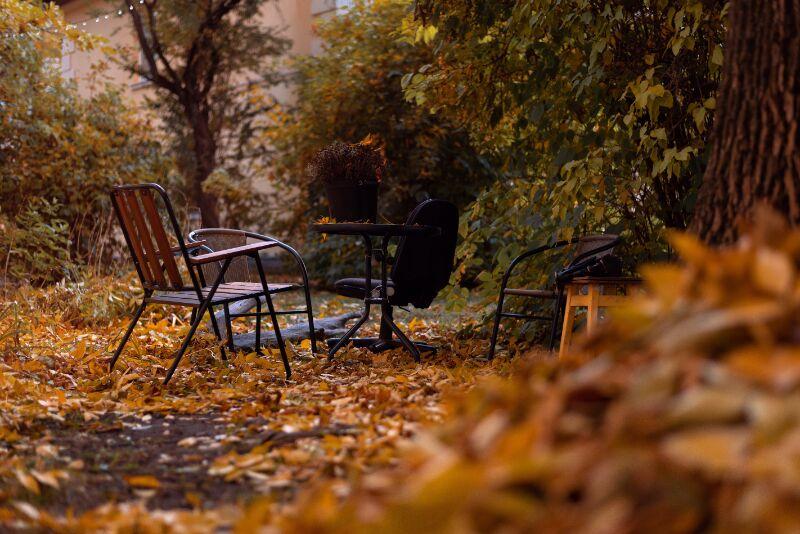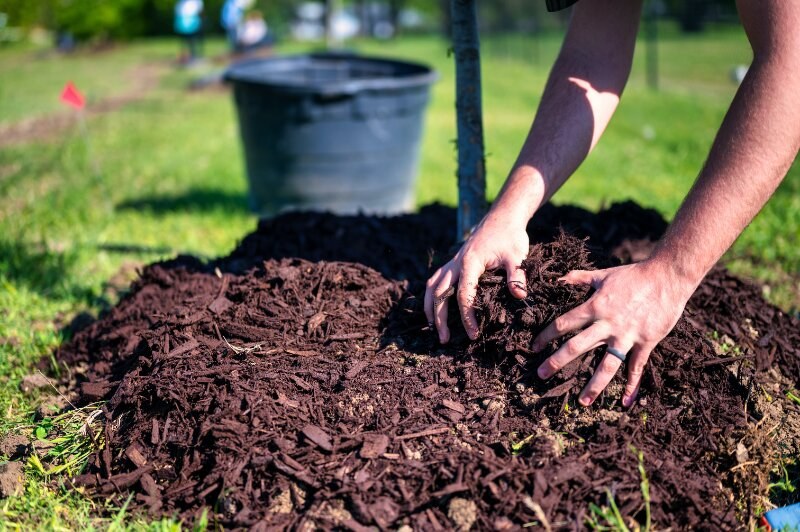Fall Lawn Cleanup: Raking, Mulching, and Leaf Management
Reading time: 8 minutesFall is a very important time for your lawn. As the weather gets colder and leaves start to drop, you need to do less mowing and more leaf cleanup. How well you manage your lawn and leaves in the fall determines how it survives the winter and, ultimately, how vibrantly it returns in the spring.
Here are our best tips for fall lawn care and how Green Drop can help you get a beautiful, healthy lawn all year!

The Problem with Autumn Leaves
The annual accumulation of autumn leaves creates a colourful, picturesque backdrop across western Canada, but only for so long. As dead leaves pile up, homeowners can face multiple problems:
- Thick layers of leaves can block sunlight, air, and essential nutrients from reaching the grass and soil. Over time, this can result in the suffocation of your lawn.
- Moist, decomposing leaves also provide the perfect environment for spreading mould and attracting pests like mice or ticks. If not addressed, this can cause long-term damage.
- When leaves accumulate in your gutters or block drainage systems around your house, this can cause issues with water runoff and put you at a higher risk of roof leaks or flooding.
- In areas prone to wildfires, dry leaves are a hazard. It only takes a tiny spark to ignite them, and the fire could spread quickly to your home.
This makes it essential to take action early when autumn arrives, and the leaves start dropping. At best, waiting could reduce your lawn's aesthetic appeal and health or even your neighbourhood. At worst, it could result in a catastrophic home fire, pests, mould, and mildew.

Best Practices for Fall Leaf Management
With fall leaf cleanup being so critical for the health of your lawn, it’s a good idea to follow some best practices for raking, mulching, and disposing of your autumn leaves.
What you do and how you do it can significantly affect the overall results you get. Keep these helpful tips in mind.
Raking
Raking leaves in the fall is more important than most people think. While letting the nutrients from leaves absorb into your lawn can benefit it, you need to mulch them first. When leaves are left alone, they can become matted down by rain and snow, which makes it harder for your grass to grow underneath.
It's also a critical task for the health and beauty of your neighbourhood. Clean, well-kept lawns without leaf litter look nicer and attract fewer pests to nest in the area.
Best Practices for Fall Raking
- Start early. Don’t wait for leaves to accumulate so you “only have to rake once.” Commit to raking often and in small batches as soon as the leaves begin to fall.
- Invest in a quality rake. Using a rake designed for picking up leaves makes the task easier and reduces the risk of damaging your lawn.
- Be gentle. Avoid raking aggressively or over large sections of your lawn. Instead of raking all of the leaves to one side, make smaller piles throughout your yard.
You can also use an electric leaf blower instead of a manual rake to gather leaves in one area where they can be mulched, composted, or put in a leaf bag and thrown away.
Mulching
Mulching is a great way to get rid of your fall leaves and nourish your lawn at the same time. There are many advantages to mulching your lawn, including helping it retain moisture throughout the winter when the drought risk is high.
A thick layer of mulch also acts as a natural weed suppressant by blocking sunlight from reaching weed seeds and preventing them from sprouting. Soil temperatures are better regulated, and the root system of your lawn is protected from snow and ice, too.
Best Practices for Autumn Mulching
- Mulch when your leaves are dry. Wet leaves can clump together, causing damage to your mower and making the mulch less effective.
- Aerate your soil first. Aerating your soil before mulching leaves helps improve oxygen circulation throughout the mulch and prevents mould and mildew while improving nutrient absorption.
- Mow at the right height. Set your mower to the highest setting so the leaves can be chopped into small pieces without cutting too much grass beneath them.
- Mow in layers. If you have a lot of leaf cover, make multiple passes to ensure the leaves are thoroughly shredded.
- Spread out the shredded leaves. Distribute chopped leaves evenly across your lawn to create a "blanket" of mulch. Avoid making large piles that can suffocate the grass.
- Mix your mulch with grass clippings. If possible, mulch leaves and any grass clippings you have left over from mowing. This combination provides a good balance of carbon and nitrogen for decomposition.

Composting
Composting leaves in the fall is an environmentally responsible and sustainable practice that offers numerous benefits for your lawn and the ecosystem. Composted leaves transform into a nutrient-rich, dark, crumbly material known as "leaf mould."
Leaf mould is an excellent soil conditioner, adding extra carbon, nitrogen, and other critical compounds and microorganisms to improve fertility.
Compost-rich dirt retains moisture more effectively without increasing the risk of mould or mildew like leaf litter. This results in a healthier, more resilient lawn and garden, or wherever you apply your compost fertilizer.
Best Practices for Composting Your Fall Leaves
- Layer leaves with other compostable materials. Use kitchen scraps, soil, grass clippings, and other materials that are rich in nutrients to help balance carbon and nitrogen ratios for effective decomp.
- Strike a balance between "green" and "brown" materials. Green materials, like fresh grass clippings and vegetable scraps, are high in nitrogen, while brown materials, like leaves, are high in carbon. You want equal amounts of both for the best results.
- Aerate your compost pile. Regularly mix your compost to aerate it and introduce oxygen. This keeps mould and mildew down and helps speed up the composting process.
- Cover your compost and monitor the temperature. Covering your compost pile with a tarp or using a container with a lid specially designed for composting can help retain heat and moisture, which are necessary to break down organic matter.
- Avoid composting diseased tree leaves. Don't compost leaves from plants or trees showing signs of diseases or fungi to prevent them from spreading through your compost pile and into your garden.
Disposal
Many cities and homeowners associations in Canada require fall leaves to be cleaned up and disposed of promptly. Excessive leaf accumulation, while magical-looking, poses safety hazards and can clog stormwater drains and culverts.
People can trip and fall over piles of leaves, and in dry conditions, leaf buildup can be a severe fire risk. Disposing your leaves gives your lawn a tidy appearance and is a good option for homeowners with abundant leaves that can't all be mulched or composted.
Best Practices for Fall Leaf Disposal
- Use biodegradable leaf bags. If you bag up your leaves for disposal, use a biodegradable option that doesn't introduce more plastic waste into the environment.
- Opt for curbside leaf collection. Many towns offer curbside leaf collection services in the fall and early winter. Check with your municipality to determine if this is available in your area. If it is, ask what guidelines they have for bagging or bundling your leaves for disposal and follow them precisely.
- Don't burn your leaves. The NASA Earth Observatory reports that in 2023 alone, Canada lost 18.4 million hectares to wildfires, many of which were caused by burning dry leaves to dispose of. This practice also harms the environment and lowers the air quality in your area.
The Benefits of Professional Fall Lawn Cleanup
Fall lawn cleanup can be time-consuming, especially for those with expansive properties or detailed landscaping. And if you don't have the right tools or equipment, you might not even be able to finish the job.
However, professional lawn care experts do. They thoroughly understand the specific needs of lawns during the fall and how to prepare for the winter to ensure your lawn stays healthy all year.
They can assess the condition of your lawn, identify potential problems, and take the appropriate steps to mitigate them. This way, you don't have to invest in equipment, spend weekends doing yard work, or deal with the hassle of disposal.
Green Drop Is Your Autumn Lawn Care Partner
At Green Drop, we understand autumn lawn care and are here to provide you with comprehensive services designed to ensure you have a healthy and vibrant-looking lawn. Contact us today to learn more or to schedule a time for our qualified lawn experts to visit your location for a quote.

